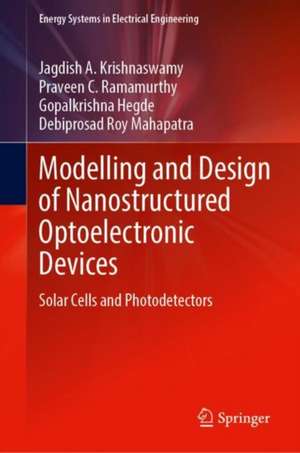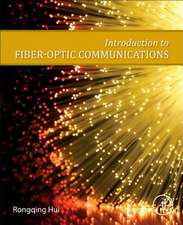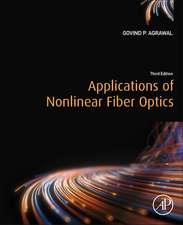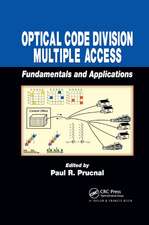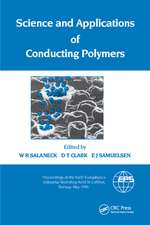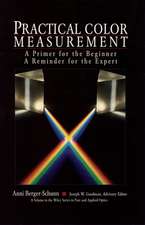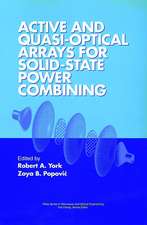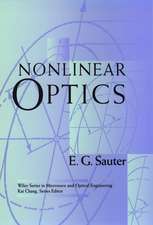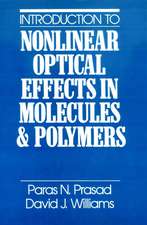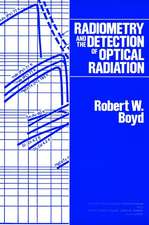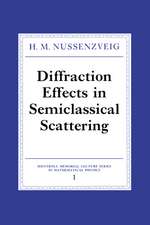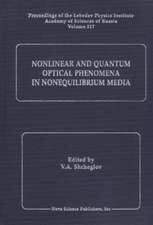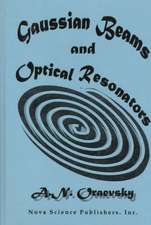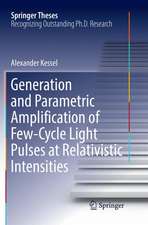Modelling and Design of Nanostructured Optoelectronic Devices: Solar Cells and Photodetectors: Energy Systems in Electrical Engineering
Autor Jagdish A. Krishnaswamy, Praveen C. Ramamurthy, Gopalkrishna Hegde, Debiprosad Roy Mahapatraen Limba Engleză Hardback – 3 apr 2022
| Toate formatele și edițiile | Preț | Express |
|---|---|---|
| Paperback (1) | 782.69 lei 6-8 săpt. | |
| Springer Nature Singapore – 4 apr 2023 | 782.69 lei 6-8 săpt. | |
| Hardback (1) | 788.09 lei 6-8 săpt. | |
| Springer Nature Singapore – 3 apr 2022 | 788.09 lei 6-8 săpt. |
Din seria Energy Systems in Electrical Engineering
- 15%
 Preț: 643.34 lei
Preț: 643.34 lei - 15%
 Preț: 640.06 lei
Preț: 640.06 lei - 18%
 Preț: 1404.46 lei
Preț: 1404.46 lei - 24%
 Preț: 786.71 lei
Preț: 786.71 lei - 24%
 Preț: 967.56 lei
Preț: 967.56 lei - 20%
 Preț: 572.58 lei
Preț: 572.58 lei - 20%
 Preț: 552.17 lei
Preț: 552.17 lei - 18%
 Preț: 944.99 lei
Preț: 944.99 lei - 18%
 Preț: 1108.36 lei
Preț: 1108.36 lei - 18%
 Preț: 727.18 lei
Preț: 727.18 lei - 18%
 Preț: 959.19 lei
Preț: 959.19 lei - 18%
 Preț: 892.90 lei
Preț: 892.90 lei - 15%
 Preț: 659.02 lei
Preț: 659.02 lei - 15%
 Preț: 638.24 lei
Preț: 638.24 lei - 15%
 Preț: 643.84 lei
Preț: 643.84 lei - 15%
 Preț: 644.63 lei
Preț: 644.63 lei - 24%
 Preț: 1865.57 lei
Preț: 1865.57 lei - 15%
 Preț: 641.71 lei
Preț: 641.71 lei - 18%
 Preț: 722.75 lei
Preț: 722.75 lei - 20%
 Preț: 463.97 lei
Preț: 463.97 lei - 15%
 Preț: 634.18 lei
Preț: 634.18 lei - 20%
 Preț: 543.68 lei
Preț: 543.68 lei - 18%
 Preț: 736.64 lei
Preț: 736.64 lei - 18%
 Preț: 889.29 lei
Preț: 889.29 lei - 18%
 Preț: 777.20 lei
Preț: 777.20 lei - 18%
 Preț: 1123.35 lei
Preț: 1123.35 lei - 18%
 Preț: 782.69 lei
Preț: 782.69 lei - 15%
 Preț: 602.42 lei
Preț: 602.42 lei
Preț: 788.09 lei
Preț vechi: 961.09 lei
-18% Nou
Puncte Express: 1182
Preț estimativ în valută:
150.80€ • 157.87$ • 124.78£
150.80€ • 157.87$ • 124.78£
Carte tipărită la comandă
Livrare economică 05-19 aprilie
Preluare comenzi: 021 569.72.76
Specificații
ISBN-13: 9789811906060
ISBN-10: 9811906068
Pagini: 258
Ilustrații: XXXIX, 258 p. 133 illus., 125 illus. in color.
Dimensiuni: 155 x 235 mm
Greutate: 0.62 kg
Ediția:1st ed. 2022
Editura: Springer Nature Singapore
Colecția Springer
Seria Energy Systems in Electrical Engineering
Locul publicării:Singapore, Singapore
ISBN-10: 9811906068
Pagini: 258
Ilustrații: XXXIX, 258 p. 133 illus., 125 illus. in color.
Dimensiuni: 155 x 235 mm
Greutate: 0.62 kg
Ediția:1st ed. 2022
Editura: Springer Nature Singapore
Colecția Springer
Seria Energy Systems in Electrical Engineering
Locul publicării:Singapore, Singapore
Cuprins
Nanomaterials in Optoelectronics.- Introduction to Photovoltaic Devices.- Introduction to Photodetectors.- Waves and Electromagnetics.
Notă biografică
Jagdish A. Krishnaswamy is a post-doctoral researcher at the iMEMS research group at the Indian Institute of Science (IISc), Bangalore, India. Previously, he was a post-doctoral fellow at the MS2Discovery interdisciplinary institute at Wilfrid Laurier University, Canada. He obtained his Ph.D. in nano-science and engineering from the Center for Nano Science and Technology, Indian Institute of Science, in 2018. His research is focused on design and development of novel multifunctional systems by addressing key challenges relating to material design, functional electronic device design, and system design. On the fundamental front, his contributions pertain to understanding the structure-property relations in materials and functional electronic devices with complex nanoscale and multiscale structures, development of facile fabrication methods for complex structured materials. Another facet of his research includes the design and development of sensing systems for self-powered optoelectronic sensing where his contributions center around the development of new sensing techniques, smart sensing algorithms, and energy harvesting for ubiquitous sensing. The specific area of interest here is the design and development of self-powered sensing strategies for the internet of things (IoT) in the context of environmental, industrial, and structural monitoring. Praveen C. Ramamurthy is a Professor in the Department of Materials Engineering at the Indian Institute of Science (IISc), Bangalore. He received M.Sc. in Polymer science in 1995 from the University of Mysore and Ph.D. degree from Clemson University in 2004. He worked as an R&D Engineer in Therm-O-Disc, Mansfield, OH, USA, and Research Scientist in Hoku Scientific, USA. He is also Associate Faculty in the Centre for Nano Science and Engineering and Interdisciplinary Centre for Energy Research. His current research focuses on organic electronics including the synthesis of conjugated polymers for application in photovoltaics and sensors, and device package application with a focus on stability and large-area device fabrication. His work also focuses on solid-state organic sensors for analytes like VOCs, heavy metal ions, nitrate, and biosensors. He has over 190 peer-reviewed papers published and 18 patents to his credit.
Gopalkrishna Hegde received his M.Sc. and Ph.D. in Physics from Indian universities. He is currently Research faculty with the BioSystems Science and Engineering and was also with Aerospace Engineering, and CeNSE, Indian Institute of Science, Bengaluru. He was an Associate Professor in UK Open University Singapore, and Research Director at the NP-AEM Centre of Innovation, Singapore (2002-2007). He has over 180 publications, in peer-reviewed journals and conference proceedings, two review articles, and has granted/filed 6 patents. He has guided several M.S./M.Tech. and Ph.D. students. He has presented invited talks/keynotes at various institutions and international conferences. He has completed many sponsored research projects in India and Singapore. He was a consultant to few industries in Singapore and India. He was Visiting Professor/Scientist in the FEMTO-ST Institute, Université de Franche-Comté, France, Univ. of Rennes France, Univ. of California, LA USA, and NTU Singapore. His current research interests are in the areas of photonics, optical sensors, photovoltaics, optical flow visualization, imaging biophotonics, nanofabrication, and opto-microfluidics.
Dr. Debiprosad Roy Mahapatra is an Associate Professor of Aerospace Engineering and currently holds the DRDO Chair at the Indian Institute of Science (IISc). He is a fellow of the Indian National Academy of Engineering and served in the SPIE Smarts Structures Conference committee, AIAA International Outreach Group, and ASTM committees, several program committees related to aerospace engineering and technologydevelopment in India. His technical contributions are in the areas of Structural Health Monitoring as an element of design in the way the next generation damage-tolerant structures with sensors will be designed and operated; advanced composite materials modeling, simulation, design, and manufacturing scale-up approach; and sensors, detection techniques, and integrated devices for applications in non-destructive inspection and other areas such as materials, devices and processes for smart, nano- and bio-technology applications. He has contributed to the advancement of theory and computational framework for wave propagation in complex media, its application in engineering problems such as acoustic and electromagnetic sensing for systems health monitoring. He has lead many multi-institutional research projects in the related field and the research outcomes have been translated to industry applications. He teaches structural mechanics and aerospace structures at the Department of Aerospace Engineering, Indian Institute of Science for graduate students, and leads research and development activities with a large team of postdocs, graduate students, and project staff.
Gopalkrishna Hegde received his M.Sc. and Ph.D. in Physics from Indian universities. He is currently Research faculty with the BioSystems Science and Engineering and was also with Aerospace Engineering, and CeNSE, Indian Institute of Science, Bengaluru. He was an Associate Professor in UK Open University Singapore, and Research Director at the NP-AEM Centre of Innovation, Singapore (2002-2007). He has over 180 publications, in peer-reviewed journals and conference proceedings, two review articles, and has granted/filed 6 patents. He has guided several M.S./M.Tech. and Ph.D. students. He has presented invited talks/keynotes at various institutions and international conferences. He has completed many sponsored research projects in India and Singapore. He was a consultant to few industries in Singapore and India. He was Visiting Professor/Scientist in the FEMTO-ST Institute, Université de Franche-Comté, France, Univ. of Rennes France, Univ. of California, LA USA, and NTU Singapore. His current research interests are in the areas of photonics, optical sensors, photovoltaics, optical flow visualization, imaging biophotonics, nanofabrication, and opto-microfluidics.
Dr. Debiprosad Roy Mahapatra is an Associate Professor of Aerospace Engineering and currently holds the DRDO Chair at the Indian Institute of Science (IISc). He is a fellow of the Indian National Academy of Engineering and served in the SPIE Smarts Structures Conference committee, AIAA International Outreach Group, and ASTM committees, several program committees related to aerospace engineering and technologydevelopment in India. His technical contributions are in the areas of Structural Health Monitoring as an element of design in the way the next generation damage-tolerant structures with sensors will be designed and operated; advanced composite materials modeling, simulation, design, and manufacturing scale-up approach; and sensors, detection techniques, and integrated devices for applications in non-destructive inspection and other areas such as materials, devices and processes for smart, nano- and bio-technology applications. He has contributed to the advancement of theory and computational framework for wave propagation in complex media, its application in engineering problems such as acoustic and electromagnetic sensing for systems health monitoring. He has lead many multi-institutional research projects in the related field and the research outcomes have been translated to industry applications. He teaches structural mechanics and aerospace structures at the Department of Aerospace Engineering, Indian Institute of Science for graduate students, and leads research and development activities with a large team of postdocs, graduate students, and project staff.
Textul de pe ultima copertă
This book approaches the design of functionally superior optoelectronic devices through the use of bio-inspired nanostructures and multiscale material structures through a step-by-step approach. The book combines both the fundamental theoretical concepts involved in understanding and numerically modelling optoelectronic devices and the application of such methods in addressing challenging research problems in nanostructured optoelectronic design and fabrication. The book offers comprehensive content in optoelectronic materials and engineering and can be used as a reference material by researchers in nanostructured optoelectronic design.
Caracteristici
Focus on bio-inspired nanostructured optoelectronic devices with improved optical and charge transport Unified theoretical foundation for optoelectronic device modelling Example based demonstration of systematic design and fabrication of nanostructured optoelectronic devices
